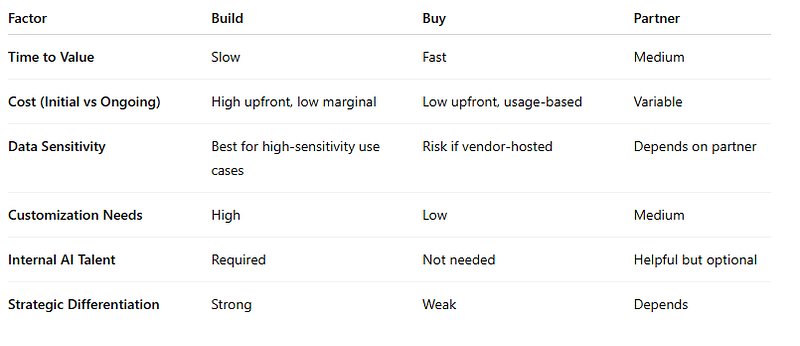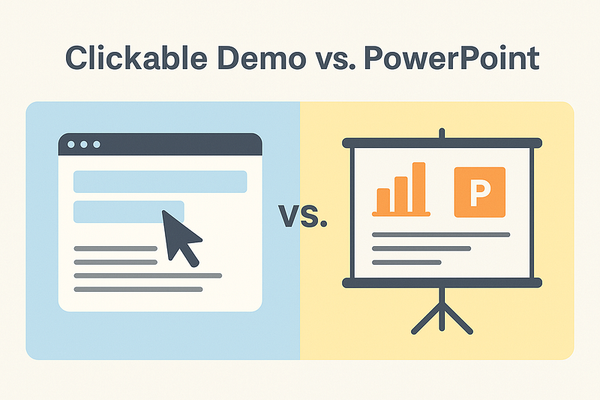The CTO’s Edge: Rethinking Build, Buy, Partner in the Age of AI
The “build, buy, or partner” conversation isn’t new. We’ve been navigating that one forever. AI just made it messier, or maybe more urgent…

The “build, buy, or partner” conversation isn’t new. We’ve been navigating that one forever. AI just made it messier, or maybe more urgent. Hard to tell sometimes.
There’s pressure now to do something with AI. Show progress. Prove we’re not falling behind. But let’s be real: most of what’s out there is either half-baked, overhyped, or doesn’t fit into the way your actual business runs. Still, we’re expected to figure it out. Take a stance and move.
So here’s how I’ve started thinking about it. Not clean, not perfect, but it’s the lens I’m using right now to make sense of the noise.
Build
This one’s tempting, especially if you’ve got smart people and a pile of proprietary data. There’s a certain appeal in crafting something that actually fits your workflows… not some generic productivity booster with a glowing AI badge slapped on top.
But building comes with baggage. Not just the upfront engineering lift: the maintenance, the drift, the governance overhead, the weird bugs that show up months later and nobody knows who owns them anymore.
If you’re gonna build:
- Get product and engineering aligned early. Otherwise you’re just playing around.
- Pick models you understand and can control. Doesn’t have to be open-source, but it should be transparent.
- Make sure you can actually use the data you have to develop what you’re thinking about…sometimes client agreements or regulations may not let you.
- Think in chunks. Modular agents, clean APIs, reusable stuff. Otherwise it spirals.
- Build feedback loops in from the start. AI breaks in slow motion if you’re not watching.
Only makes sense if what you’re solving actually matters. Not everything does.
Buy
Buying sounds easy. And can be… until the invoice hits or the tool doesn’t actually do what the sales deck promised or your team’s already swamped with other priorities. Still, there’s a place for it: quick wins, standard tasks, proving there’s a market or problem to solve before investing in building, and of course, stuff that’s not worth building.
But it’s a bit of a trap too. You start with one team using it for email summaries, and the next thing you know, finance is asking why your AI bill doubled last month. Agent-based pricing models are sneaky like that.
If you buy:
- Run a tight pilot. Contain it. Watch usage.
- Don’t skip the boring stuff: procurement, security, privacy reviews. This stuff can bite you later.
- Bake training and support into the rollout. People won’t adopt what they don’t understand. Culture change and getting people onboard may be the hardest part.
- Push vendors hard on roadmap transparency. Lots of smoke and mirrors out there. Ask for pilots and POCs funded by the vendor before you sign the contract.
And yeah… watch out for lock-in. Getting out can be harder than getting in.
Partner
Sometimes you just don’t have the bench. Or the time. Or the appetite to commit. And you can’t find something off the shelf that does what you need. That’s where partners come in. External help can be a huge boost, or a total distraction. Depends on how you structure it.
Don’t outsource the thinking. Or the strategy. Keep the steering wheel.
If you’re gonna partner:
- Define the problem like your budget depends on it. Because it probably does.
- Find someone who’s done this before. In your space and with companies like yours.
- Stay close. Weekly check-ins. Live demos. Don’t wait until the “final delivery” to find out they missed the mark.
- Make sure you own your IP. It’s not just about code, it’s the ideas, the process, the data paths.
Partnerships work best when you already know what you’re trying to solve, and you just need a little extra muscle to move fast.
So how do you decide?
Here’s what to think through when deciding between build, buy, or partner:
- Is this something we’d be proud to build, does it enhance our moat or enterprise value or are we just doing it because we can?
- Do we need to own this long-term?
- What’s the cost of doing nothing for six months?
- How much are we betting that AI actually changes this part of the business?
- What happens if it’s not successful?
Honestly, sometimes the hardest part is just deciding to start.
The Playbook (if you want to call it that)
Not really a playbook. More like rough steps I’ve seen work.
Start small
Internal use cases are safe. Fewer politics. Easier to learn. Summarization, classification, automating manual task… that kind of stuff.
Run a pilot
Pick a team that’s game to try new things. Give them support. Track outcomes loosely. Don’t get too wrapped up in dashboards and metrics at this stage, just pay attention.
Make adoption frictionless
If it’s not in Slack, or Teams, or the tool they already live in… they won’t use it. Don’t overthink it.
Don’t skip governance
Even if you’re early. Set expectations. What’s allowed, what’s not. Where the data goes. Who’s watching. You don’t want to be the one cleaning up the mess later.
If it works, scale
Build a shared repo of tools, agents, prompts, whatever. Let teams browse and borrow. Centralize just enough to keep things from spiraling, but not so much that it kills momentum. But also start thinking about how you’re going to govern and manage it all.
One Last Thing
Everyone’s chasing AI right now. Feels like we’re all supposed to have a bold vision and a three-year roadmap.
But honestly, the better move might be starting with something small that actually works. Show value. Learn. Build credibility. Then go from there.
Not “AI transformation.” Just progress.
That’s usually enough.


